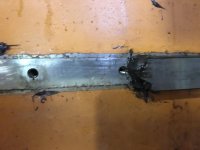Dojustly
Plastic
- Joined
- Jan 16, 2013
- Location
- Nashville area
Good morning all!
My company's fab division has a very large Peddinghaus saw which uses linear guides to position the sawblade depending on material size. One of the rails broke, and I have been tasked with repairing/replacing it.
The saw is very old, so I'm unsure I will be able to find a replacement to buy from Peddinghaus, although I haven't checked yet.
If I need to machine a replacement, I have several questions: What material would you use? Broken pc seems to be cast and machined/ground. 4140 or tool steel needed? I have no idea.
I can model the profile, so I feel like I'd be able to machine a replacement, although the length will require me to machine in 2 setups each side.
Am I going about this all wrong?
Any ideas would help! Thanks!
My company's fab division has a very large Peddinghaus saw which uses linear guides to position the sawblade depending on material size. One of the rails broke, and I have been tasked with repairing/replacing it.
The saw is very old, so I'm unsure I will be able to find a replacement to buy from Peddinghaus, although I haven't checked yet.
If I need to machine a replacement, I have several questions: What material would you use? Broken pc seems to be cast and machined/ground. 4140 or tool steel needed? I have no idea.
I can model the profile, so I feel like I'd be able to machine a replacement, although the length will require me to machine in 2 setups each side.
Am I going about this all wrong?
Any ideas would help! Thanks!



